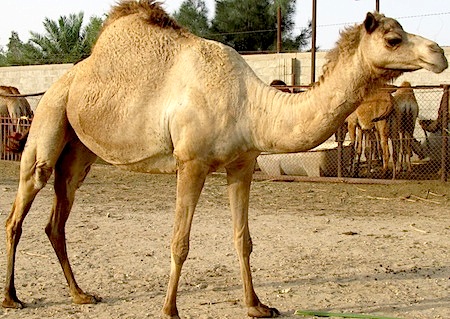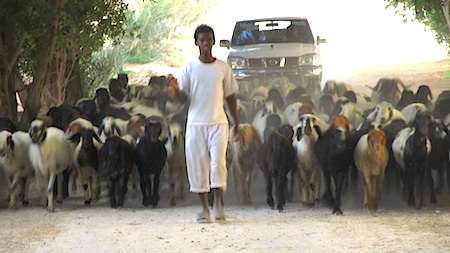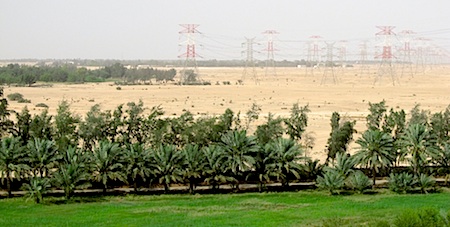
DOHA, Qatar –Mohamed Ali Darwish, a principal investigator at the Qatar Environment and Energy Research Institute, and one of the Gulf region’s leading experts on desalination, is a mechanical engineer assigned to help this dry nation of nearly two million residents develop a more efficient and ecologically safer means for securing its freshwater supply. Since 1959, when a Scottish engineer developed what is called “multi-stage flash evaporation,” or MSFE, Gulf coast nations have ardently pursued the extraordinarily reliable but hyper energy-consuming technology to produce their drinking water.
Qatar, which operates eight major desalination plants, is so confident about the technology, regardless of the energy consumption, that it is preparing to build a ninth MSFE installation at the Ras Abu Fontas water plant on the Gulf shore south of Doha.
As I noted in an earlier post, risks to the Gulf’s ecology and energy security are tightly wrapped up in the program pursued by Qatar and its neighbors to produce desalinated water. Qatar’s production, 1.5 million cubic meters daily, is said by authorities here to represent five percent of the Gulf’s total production of desalinated water.
The new plant will increase production by roughly 10 percent annually when it opens in the spring of 2015. Plant managers, who led us in a discussion and tour of Ras Abu Fontas, declined to disclose the cost of construction. But they did note that of the 1.5 million cubic meters of desalinated water produced in Qatar, half by the Ras Abu Fontas Plant, about a third is wasted once it leaves the plant boundaries. Leaking pipes managed by a separate state-owned utility have not been repaired or replaced, and precious water is draining away, they said.
In an interview, Dr. Darvish noted that more than 10 percent of the nation’s domestic natural gas consumption and a fifth of its electricity is devoted to producing desalinated water. I mentioned what we’d been told earlier in the day, that a third of the water produced never makes it to domestic taps and toilets. Given the energy demands and cost of building a new plant to produce more water, I asked whether it would be more efficient and less expensive to upgrade the water transport infrastructure?
Darvish immediately arched his eyes and shifted in his chair. “You see,” he said. “This is Qatar.”
Since December 2008, when I joined colleagues at Circle of Blue to report on the drought-driven collapse of farm production in Australia’s Murray Darling River Basin, I’ve journeyed across the United States and the world to better understand the implications of the contest between rising demand for energy and food, and diminishing reserves of fresh water. The privilege of spending weeks in China, and in India, also produced events, generated new friendships, and yielded insights about how nations managed under the stress of providing enough water, food, and energy, even as they contended with the powerful collision between economic, ecological, civic, and governmental interests. Very clearly, the Earth is pushing back and human systems are being forced to adjust.
Qatar, small as it is, occupies a place at the table of nations that are part of the problem and at work on the solutions. Since 2008, when food grain supplies plummeted and prices jumped sharply around the world, in part because of the collapse of Australia’s Murray-Darling Basin rice industry, Qatar launched a new national project to develop a formula for making itself less vulnerable by pursuing an ecologically and economically sustainable way to produce energy, secure food, and yield a safer quality of life.
The basic ingredient fueling the new formula, though, is Qatar’s own treasure trove of oil and natural gas. While such alchemy is intensely significant, whether it’s possible to yield a golden future from an oil-rich present is not at all assured. But the process of exposing the basic ingredients to new substances and new ways to mix them also produces distinctive narratives that I call TIQ. This is Qatar:
1. Qatar is an import nation like no others, except its Gulf region neighbors. Save for supplying all of its own energy — the result of rich fields of oil and gas in the country’s west and north — virtually every other feature of Qatar’s national existence comes from someplace else. That includes workers. Some 1.5 million laborers, craftsmen, professionals, scientists, engineers, drivers, teachers, marketers, lawyers, consultants, technicians — you name it — are recruited from other nations to toil here. Indians make up the largest group, according to government statistics, forming 24 percent of the workforce. Nepalese (16 percent), other Arab nations (13 percent), Filipinos (11 percent), Sri Lankans (5 percent), Bengalese (5 percent), and Pakistanis (4 percent) are the other big groups.
2. The size of that workforce, its gender percentages, its earnings, and the amount of money it sends out of the country to families in the home countries are much-discussed topics in the media here and in other Gulf nations. All of the Gulf nations are contract societies and the costs of recruitment and residence are evolving into political issues. Kuwait, for instance, is considering enacting a new cost structure for charging its contract laborers higher fees for water, electricity, housing and other incentives that attracted workers to that country in the first place.
Here in Doha, the issue is recruiting maids for Qatari households, and the homes of highly paid emigre executives. Most Qatari households have at least one, and generally two or three maids. High income emigre professionals also hire maids. There are some 55,000 so-called domestic workers recruited to Qatar each year now, 6,000 more than in 2009, according to government statistics. They come from all over the world and earn $200 to $250 a month. The government in Manila has protested recruiting maids in the Philippines, most of them young women, insisting that wages are too low — Manila wants $275 in minimum maid wages monthly. Manila also insists that the fees Filipinos pay to be recruited (around $3,000) are too high. Qatar, meanwhile, argues that it needs to widen its source pool and that recruiters will look for domestic laborers in Vietnam, Bosnia-Herzegovina, Cambodia, and Bangladesh. The government also says it wants maids, according to local news reports, with “prior experience of working with families in the Gulf and know at least a smattering of Arabic.” This is Qatar.
3. There’s no talk of a budget deficit in this nation. The latest accounting shows that Qatar has over $62 billion in surplus funds in its national account, representing 32.4 percent of the country’s 2012 GDP of nearly $200 billion. If the U.S. had a similar percentage in surplus, that would amount to over $5 trillion. The Qatari surplus, dependent on the rise or decline of global prices for oil and natural gas, is likely to increase again in 2013.
4. The entire nation is under construction. The country’s expanding budget and surplus are financing all kinds of projects — $12 billion annually in infrastructure development — that are devoted to two principal objectives:
— Introducing the 21st century Qatar to the world when Doha hosts the 2022 World Cup.
— Executing a national development strategy that is focused on converting the hydrocarbon economy to a knowledge-based and more ecologically sustainable economy. Qatar, for instance, invests 2 percent of its GDP on science and research. The Qatar Environment and Energy Research Institute is pursuing the feasibility of building a solar-powered desalination plant that would use energy-conserving reverse osmosis technology.
The most visible evidence of Qatar’s public wealth is the expanding fleet of heavy trucks and construction equipment. Qatar is building a new airport in Doha, a new metro rail transit network, an education and research campus that encompasses 15 million cubic meters, a national heritage museum, a national library, tens of millions of square meters of new office and residential space, and new roads and highways. There is so much desert being dug up, turned over, and collected in piles that air quality measurements show that concentrations of dust in the air are increasing. Recent emigres complain of coughs and other respiratory nuisances they say never occurred back home.
5. Alcoholics need not apply. Islamic precepts generally forbid intoxicants, including alcohol. Native born Qataris don’t drink for the most part, though drug use is said by authorities to be on the rise. Qatar does provide for alcohol consumption for emigre laborers. But its use is discouraged through tight oversight in Doha’s sole liquor store, and by exceptionally high prices in the luxury hotel bars where it is served.
There are no corner pubs in Qatar. There is a liquor store where emigre customers are eligible to purchase alcoholic beverages if they successfully complete the formal application for a liquor card with their name and picture on it. Applicants must secure a letter from their employer and state their monthly incomes. The latter is used — really — to calculate how much the applicant is allowed to spend each month on booze, wine, and beer. The idea is to discourage bootleg sales. During Ramadan, the annual month of fasting, liquor purchase budgets are tripled.
For those who like to enjoy a beer after work — raise your hands — guard your wallets. The evening prior to my departure I toasted the fine week here with new friends. Bottles of Heineken were $14 apiece.
Given that Qatar’s social conventions around entertainment are much stricter than much of the rest of the world, you have to wonder what the nation’s leaders intend when World Cup fans arrive in 2022. This, afterall, is not a group of tea drinkers. Will Qatar try to pull off the first dry World Cup?
6. Dogs. Billboards. What dogs and billboards? During all the hours spent in moving vehicles last week I saw two dogs and no advertising billboards. The billboard restrictions seem easy to understand. It’s a barrier to the powerful cultural and marketing influences occurring outside Qatar. But the paucity of dogs? Anybody have an answer for that?
7. Qatar’s leaders hold an Annual Research Forum, during which the nation’s principle impediments are thoroughly explored and solutions proposed. In a nation challenged by obstinate impediments — water scarcity, food supply, labor recruitment, indolence prompted by wealth, diabetes and hypertension, uncertain global energy prices — still one more serious problem has followed swift growth. That challenge is brutal traffic. There are no easy and fast drives across Doha during business hours. The population of vehicles is increasing faster than the human population. Roads are packed. Drives that took 20 minutes two years ago now take an hour.
8. The thobe. Last week I reported on Qatar’s women in black. I also learned about Qatar’s men in white. The spotless white neck-to-ankle robe that Qatari men wear in public is called a thob (pronounced thobe), and includes a starched dress collar. Men also wear a flared white scarf, called a gutra (gootrah), that covers their heads and drapes to well below the shoulders. It is is held in place with assistance from a coiled braid of black that is called an eqar.
Thobe styles and gutra fabrics distinguish nationalities in the Gulf region. Red and white checkered gutras generally are worn by Saudi men. Thobe collar styles distinguish Qataris from Kuwaitis from Omanis.
Qatar’s young men look strong and graceful in their thobes, which are studiously unblemished by stains. I asked a new friend named Mohammed Al-khori, how he and his friends keep their thobes so clean, so white? He said that Qatari boys learn polished table manners pretty quickly, perfecting the art of drinking and eating without spilling stuff on themselves. As adults they know that a stain that occurs at a meal outside their homes stays with them all day long.
TIQ. This is Qatar.
— Keith Schneider



4 thoughts on “TIQ: This is Qatar”